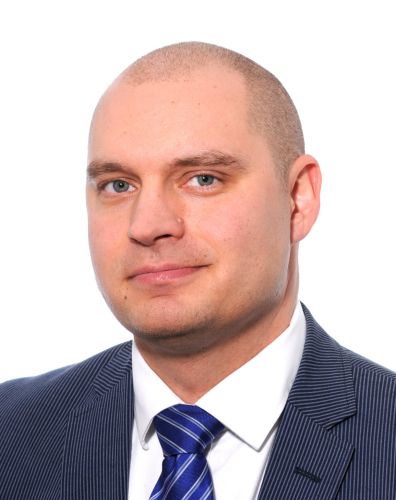
Sticky notes and spreadsheets are no longer enough
Modern healthcare production management frees up resources for productive work
Published: 16 January 2023
Healthcare information systems contain vast amounts of information about customers, employee numbers, and facility usage. But this information is often very scattered, and only a fraction of it is utilised in the planning of work. Smart production management improves forecasting, frees up healthcare professionals' time for patient work, and relieves healthcare congestion.
"Everyone knows that the resources are not going to increase, but the number of customers and the demand for services are on the increase as we speak", says Harri Halinen, Project Manager for the wellbeing services county of Kanta-Häme.
Halinen is responsible for the planning and implementation of the IT system for the region’s new central hospital. The Assi Hospital in Ahvenisto, which will be commissioned in 2026, will be one-fifth smaller than the region’s previous central hospital.
"While this entails savings of millions of euros in facility costs, it simultaneously requires overall resource planning to be much more efficient than before in order to provide the services.”

situation awareness of the resource situation of the entire welfare
services county. "For example, in the casualty department,
the availability of hospital beds is visible at a glance." says Mr Halinen.
From paperwork to patient work
Human resources and facilities are both the most important and the most expensive resources in healthcare. However, resource planning often requires laborious manual work, and its transparency is often poor.
"At the moment, our resource planning is still carried out in spreadsheet programs, and even paper calendars are used", Halinen says.
"The staff has to spend a lot of time planning and sorting things out. This time is often directly taken from time spent on actual patient work.”
Tommi Koistinen, Tietoevry’s Lead Product Manager for production management solutions, says that manual work is a part of everyday life for many customers.
"Planning is often carried out with pens, papers, and by posting sticky notes on a wall. This works up to a point, but long-term planning is easily overlooked", Koistinen says.
According to Koistinen, long-term planning is precisely what could improve the effectiveness and relevance of resource allocation.

relevance of resource allocation.”, says Tommi Koistinen.
Overall picture is key
However, long-term planning is not possible without a reliable and up-to-date overall picture of the people and facilities available. This is where modern production management solutions can be of assistance.
It is essentially a question of optimisation; how to allocate the available resources as sensibly as possible, while taking into consideration both the costs and the use of professionals’ time. Healthcare information systems often contain information about e.g. the customers, the number of employees, and facilities, but this information may be scattered and difficult to put into effective use.
Modern tools can be used to consolidate the data and incorporate it into the planning process. The tools are compatible with various systems, from appointment booking software to HR management systems and from device registers to shift planning software.
Improved visibility increases predictability
Harri Halinen of the wellbeing services county of Kanta-Häme (Oma Häme) offers an example from secondary healthcare, where planning is currently primarily based on the number of referrals.
"In practice, human resource allocation has been done separately from the processing of referrals. This has not given us sufficient forecasting ability, which has manifested itself for both customers and employees as congestion", Halinen says.
At present, the customer has little opportunity to affect the scheduling of their own treatment, for example, choose the appointment time that best suits them. This leads to cancellations, which may be reflected in the work of healthcare professionals as unnecessary idle time at worst.
"Hospitals operate at an uneven pace. At times, the medical staff is insanely busy and customers get frustrated with waiting, while at other times, quiet periods may occur even though there are customers in the treatment queue.”
Oma Häme is currently in the process of implementing production management tools that can be used to schedule work within the hospital more effectively, for example.
"The aim is to enable professionals to better manage and schedule their own work, which will also make it feel more rewarding.”
The purpose of production management is to be able to provide services at the right time and at the right level. Once we’re able to incorporate data into human resource planning, we’ll also be able to free up more time for patient work. Workload can be distributed more evenly, and time can be saved by reducing secondary tasks such as looking up information or searching for devices.
In practice, production management systems and data can be used to forecast demand for services over a period of e.g. 2–6 months. For example, the occupancy rate of operating rooms can be increased by providing transparency into the provision of follow-up treatment, the availability of beds, etc.
Optimized use of facilities
After human resources, facilities are the most important resource in healthcare. As such, they are also a significant factor in production management and operational optimisation.
According to Oma Häme’s Halinen, a detailed study of facility usage conducted at the Satasairaala Hospital in Satakunta revealed that by increasing the overall occupancy rate, one fourth of the facilities could be omitted. In the future, due to its smaller size, the new Assi Hospital will bring savings of over EUR 10 million per year in facility costs.
"This will help ensure that our limited social welfare and healthcare budget is spent on exactly the right things, i.e. for the benefit of our patients.”
Facility usage in Oma Häme’s Assi Hospital will differ from that of the previous hospital: there will be no dedicated desks, and activity-based workspace solutions will play a major role in other ways as well.
"Of course, new types of facilities also require operational changes to be implemented", Halinen says.
Facility management must be transparent and as automated as possible, so that professionals will not have to spend time planning facility use but will instead be able to operate in the various workspaces in the best way possible.
Streamlining everyday work
In Oma Häme, one of the most significant benefits of production management is the situation awareness covering the entire central hospital.
"For example, in the emergency unit, the availability of hospital beds is visible at a glance. The patient can be sent directly to the right bed in the inpatient ward, without any extra inquiries or investigations", Halinen says.
In the future, situation awareness will extend over the entire wellbeing services county. This will streamline everyday work, such as transferring a recovering surgery patient into a different care unit within the region.
Having the situation picture available on mobile devices also makes the everyday life of healthcare professionals easier. A nurse or a doctor can at any given time take a look at their next working day and see how it begins. They won’t have to waste time searching for devices in warehouses, as their location can be seen on the mobile device. A patient's status can also be checked from the mobile device.
"A physiotherapist on their way to see a patient can check in advance if the patient is still in the laboratory, for example, and go do something else while waiting. Healthcare professionals will not have to waste their time, as they will always know what they’re doing", Halinen concretises.
The reform will also benefit customers. A patient scheduled for an operation can see their entire clinical pathway: for example, that before the operation, they will have a sampling appointment with the laboratory and a dental examination, and after the operation, they’ll receive physiotherapy.
Tietoevry’s Tommi Koistinen states that for situational awareness, patient flow optimisation is key.
"Production management tools can be used to identify bottlenecks and prevent them from occurring in the wellbeing services county’s service provision. In a nutshell, it is a question of optimising patient flow through optimising resource allocation.”
Koistinen points out that the combined budget of all wellbeing services counties for the year 2023 is EUR 21 billion. Sensible use of resources will have a huge impact.
"Production management will enable savings of several per cents in operational costs.”
Effectiveness through co-operation
In order for production management tools to accurately respond to the needs of the customers and actually benefit the everyday life of professionals, development work is carried out in close co-operation with e.g. nursing professionals.
Co-development provides a better understanding of the work and needs of healthcare professionals, and thus the things that have the greatest impact can be prioritised in the development work.
According to Oma Häme’s Halinen, Tietoevry's background is clearly reflected in their work.
"They have a long history in the healthcare and social welfare sector, so they have a proper understanding of the related processes. It has also been great to see that the company has been able to shift from the role of traditional patient information system provider to that of a technology neutral developer. Ecosystem thinking and supplier neutrality are important values for us", says Halinen.
Development work is carried out simultaneously between four different wellbeing services counties, which allows for extensive sharing of experiences and insights.
"Once the medical staff had seen the first demo and found it to be beneficial to their work, the reception was largely positive. The implementation of the proposed changes in the applications within only three weeks’ time has further increased the commitment level", Halinen says.
Work for the benefit of patients, not processes
Allocating existing resources more efficiently might sound like something that would increase the pace of work or cause more stress. But modern tools that support planning and everyday work will actually have the exactly opposite effect.
"The main idea behind production management is to consolidate existing information and resources and turn them into new, concrete data that can be used to support the planning process and practical work in a way that frees up time and energy for more relevant work", Koistinen says.
Production management solutions are not a the silver bullet to solve all problems, but together with the development of operating models, they bring savings and increase job satisfaction at bes. Such a combination is worth pursuing in virtually any organisation.
This article was originally published at MustRead site.
Learn more about Tietoevry's social and healthcare production management
-
30 Apr2025Press release
Tietoevry Care unveils Lifecare Resource Optimization: First end to end health care planning tool
-
14 Apr2025Press release
Tietoevry Care's Lifecare EHR delivered in the wellbeing services county of Ostrobothnia, Finland
-
9 Apr2025Press release
Tietoevry Care selected to participate in the Digital Health Nation Open Innovation challenge – advancing openEHR solutions in healthcare with Basel University Hospital
-
28 Feb2025Press release
Tietoevry Care introduces Lifecare AI Search for Care Measures – the first AI solution in municipal care in Sweden
